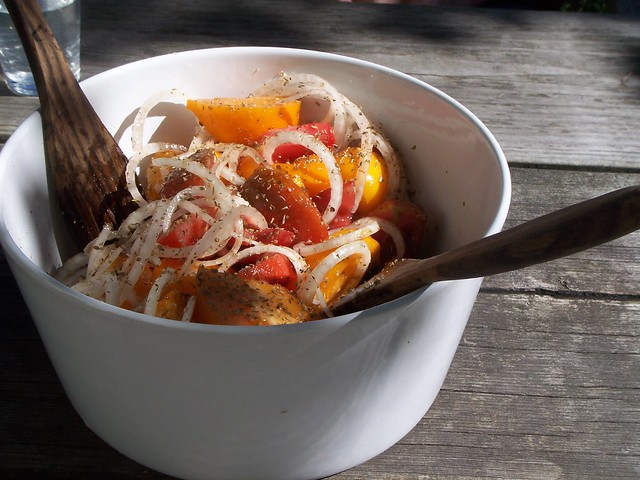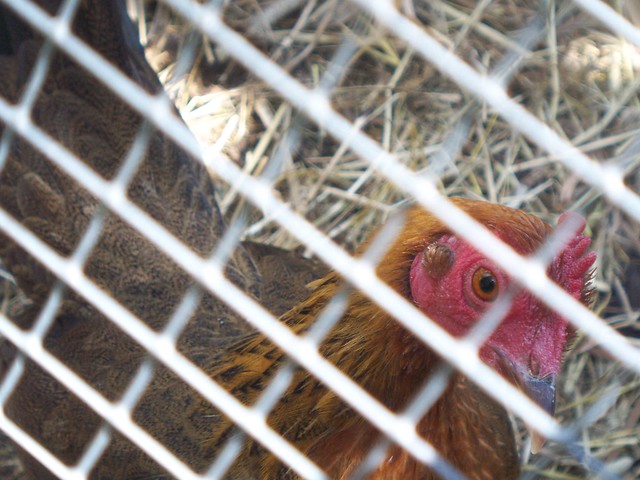
It's the worst of bad manners — and self-protection, I think, in a nervously cynical society — to ridicule the small gesture. These earnest efforts might just get us past the train-wreck of the daily news, or the anguish of standing behind a child, looking with her at the road ahead, searching out redemption where we can find it: recycling or carpooling or growing a garden or saving a species or something. Small, stepwise changes in personal habits aren't trivial. Ultimately they will, or won't, add up to having been the thing that mattered.After reading Animal, Vegetable, Miracle, I feel motivated to do something to further our journey in living green. What, I'm not sure. On one hand, I'm inspired to raise chickens and grow fruits and vegetables, to learn to can and otherwise preserve our surplus, to make everything from scratch, to shop almost exclusively at farmers markets that pop up around the city when warm weather entices everyone to spend more time outdoors. On the other hand, we have constraints. We live in an apartment building in the city with no space for chickens or a garden or a stockpile of preserves. Many farmers markets are open on weekdays, when we're both at the office. And it's New England. Farmer's market season is limited (though CSA options extend beyond it).
—Barbara Kingsolver, Animal, Vegetable, Miracle
Where does that leave me and my aspirations? What I find most compelling about Barbara Kingsolver's book is she acknowledges that conscientious eating in practice looks different for everyone. Instead of mandating what everyone should do, she highlights why the local food movement matters. She discusses the high long-term costs of our current food economy — to our health, to our environment, to our communities — and then explains how the local food movement can stem the tide through small and simple choices.
"Locally grown" is a denomination whose meaning is incorruptible. Sparing the transportation fuel, packaging, and unhealthy additives is a compelling part of the story, but the plot goes well beyond that. Local food is a handshake deal in a community gathering place. It involves farmers with first names, who show up week after week. It means an open door policy on the fields, where neighborhood buyers are welcome to come have a look, and pick their food from the vine. Local is farmers growing trust.This resonates so much more now than when I first heard about the local organic food movement. On 60 Minutes Leslie Stahl interviewed a dreamy-eyed foodie in California who seemed to suggest that every family had the money to buy expensive organic food and the time to make everything from scratch, and just did not value the flavor and experience enough to do so. We moved to Boston in the middle of the winter on one entry-level salary, and after cutting out all expenses not directly related to survival, we were left with a $40 budget to feed both of us each week. I wasn't buying $8/pound organic grapes.
—Barbara Kingsolver, Animal, Vegetable, Miracle
In contrast, Kingsolver isn't puttering around in a kitchen the size of my apartment, waxing poetic about how much better an egg tastes when it's poached in a wood fired oven. She works long hard days in her garden, revels in the first shoots of asparagus, serves as a matchmaker for her adolescent flocks of chickens and turkeys, spends late summer days in a hot kitchen canning, and builds meaningful relationships with the growers in her community. By sharing her experiences — the hardships as well as the joys of pursing local food, she inspires me to believe I can do it too, in my own way.

One of Kingsolver's keys to making local organic food economical, and therefore practical, is eating in season, whether you grow food yourself or buy from a grower or grocery store. Tomatoes in the middle of summer surplus are inexpensive. The same tomato in the middle of winter is not, due to the expense of either transporting it long distances or using lots of energy to grow it in a hothouse. Because the book follows their year-long local food experiment chronologically, it lends itself to good tips and recipes to eat seasonally (basil blackberry crumble? twist my arm). And while her family was committed to the project for one full year, she admitted once it was over, they would allow themselves more flexibility. But Italian wine and bananas would be treats, not staples.
So what are our next steps, in a small city apartment and six-month winter without outdoor space or a car? Switching our Boston Organics box to the local option (I acknowledge we may cry uncle to root vegetables by mid-February). Making a more concerted effort to see if/when we can work local farmers markets into our schedules. Finding restaurants and grocery stores that buy or even grow local (like Russos and Wilson Farm). Shifting our perspective to see out-of-area and out-of-season food as treats. Eating less meat, and making sure it's from happy healthy animals when we do. Planning meals around the seasons, instead of picking recipes first. Supporting and celebrating growers who are passionate about their craft. It is these seemingly small changes that will "add up to having been the thing that mattered."
Eat (real) food, not too much, mostly plants.
—Michael Pollen


